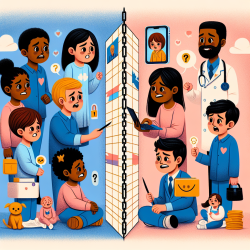Introduction
Emotion regulation is a critical component in maintaining healthy interpersonal relationships. Recent research titled "Gender differences in cognitive and affective interpersonal emotion regulation in couples: an fNIRS hyperscanning" sheds light on the neural mechanisms underlying these processes. This study provides valuable insights into how practitioners can leverage gender differences to improve therapeutic outcomes for couples.
Understanding the Research
The study employed functional near-infrared spectroscopy (fNIRS) hyperscanning to explore how couples regulate emotions differently based on gender. Thirty couple dyads participated, with findings indicating that males and females exhibit distinct neural patterns during cognitive engagement (CE) and affective engagement (AE) strategies. Specifically, males showed less neural activity in certain brain regions during CE compared to AE, while females did not exhibit significant differences between these strategies.
Key Findings
- Males demonstrated less effectiveness in CE compared to AE, indicating a potential need for more cognitive effort during regulation.
- Females showed consistent neural activity across both CE and AE, suggesting flexibility in emotional processing.
- The study identified specific brain regions, such as the dorsolateral prefrontal cortex, that are involved in these gender-specific regulatory patterns.
Implications for Practitioners
Understanding these gender differences can significantly impact therapeutic approaches. Here are some strategies practitioners can implement:
- Tailored Interventions: Customize therapy sessions by considering gender-specific tendencies in emotion regulation. Encourage males to engage in AE strategies, which may be more effective in reducing distress.
- Focus on Cognitive Engagement: For males, enhancing cognitive engagement techniques could improve their emotional regulation capabilities. This might involve cognitive-behavioral strategies that promote cognitive flexibility.
- Strengthen Affective Bonds: Since AE activates attachment bonds, fostering emotional connections in therapy can enhance regulation outcomes for both genders.
Encouraging Further Research
This study highlights the need for continued exploration into gender differences in emotion regulation. Practitioners are encouraged to delve deeper into the neural mechanisms at play and consider cultural and contextual factors that may influence these processes. By doing so, they can contribute to a more comprehensive understanding of interpersonal emotion regulation.
Conclusion
By integrating these research findings into practice, speech-language pathologists and other practitioners can better support couples in achieving healthier emotional regulation. This not only enhances individual well-being but also strengthens relationship dynamics.
To read the original research paper, please follow this link: Gender differences in cognitive and affective interpersonal emotion regulation in couples: an fNIRS hyperscanning.










